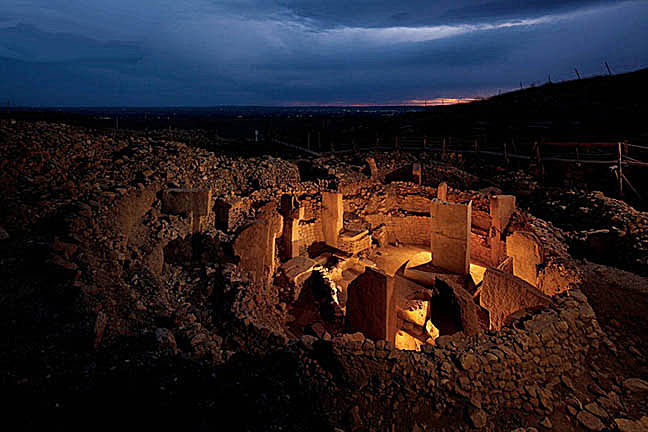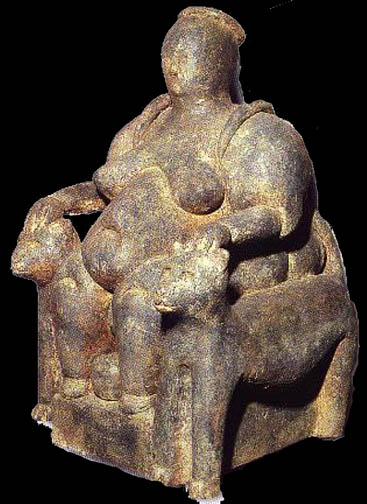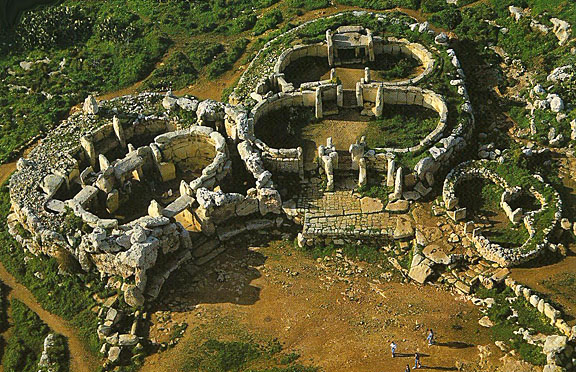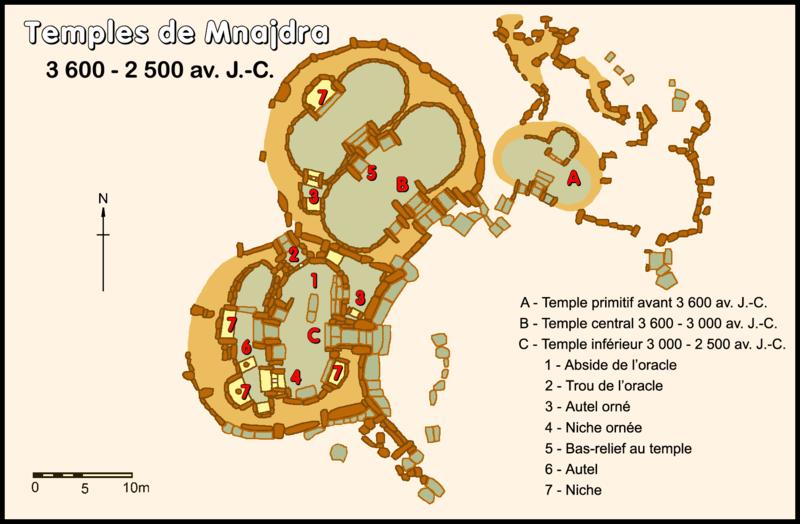
A Shaman sitting among his animals, 12 000 BC
Pre-History of Eurasia
45 000 – 4 000 BC
Before writing was invented in in the 5th milleniumm BC we have to intuit the development of belief systems from cave paintings and archeological excavations. These interpretations are necessarily open to criticism and new discoveries. Such is the case with the hypothesis of the migrations of homo sapiens from Africa to Europe via India, the discovery of the Anatolian temples in the 1960-80s, and the new theory of the origins the Indo-Europeans in Anatolia (see the Rise of Modern Man).
Paleolithic
45
000-10 000 BC

A
Shaman sitting among his animals, 12 000 BC
Tracing of the large panel of engravings in the Caves of Les Trois Freres, Ariege, France.
The great cave paintings of the Paleolithic period were painted by men of the homo sapiens tribes when they reached Western Europe in the 45th millenium BC, after spending 45 000 years in India and Pakistan following their exodus from Africa. No cave paintings have ever been attributed to Neanderthals with certainty. The paintings don't show human images until the 12th millenium BC – except for a few sculptures of woman. She is usually very voluminous – except for the shist image from the Galgenberg, where she is seen dancing, breasts swinging, one arm raised. It is probabely justified to consider these small sculptures to be “fertility charms”, which eventually during the Neolithic get differentiated into distinct representations of the various manisfestatons of the Great Goddess.
There seems to have been no systematic “religion” beyond the ministrations of shamans who tried to conjure and direct the herds of animals into the traps of the hunters.
Venus Street
38
000 – 20 000 BC
|
|
|
|
|
|
The largest number of female votive charms were found in the narrow corridor between the northern ice cap and the Alpine glaciers, roughly along the Danube Valley extending into the center of Southern France. This was the migration route of homo sapiens. For that reason I dubbed this route “Venus Street”.
|
|
|
Two aspects of “Venus XV" from Dolni Vestonice,
mammoth ivory, 23'800 BC
Artistically the most
extraordinary sculpture of the Paleolithic
Just north of Bratislava near Brno lies the abundant archeological excavation site of Dolni Vestovice, where this small ivory head was found among many lesser figures. It appears to be the portrait of a female medium or shaman whose grave was unearthed close by.
Neolithic
11 000–4
000 BC
The Neolithic Period resulted in a revolution of society and man's thinking. The first temple structures were built, probably to serve complex death and burial rites. The settlements grew larger and the paleolithic animal herds shrank: to feed the masses of people man turned to agriculture and breeding domesticated lifestock. With this development a sophisticated Great Goddess cult evolved.
The advent of metallurgical processes around 3000 BC intiated the Bronze Age. It gave the men weapons, kingdoms erose in the Near East and Egypt, wars erupted, and the administration of and trade between the new states precipitated the invention of writing. This ended the Neolithic Period. The veneration of the Goddess became incorporated into systematic, patriarchal Religions.
Göbelik
Tepe, South-Eastern Anatolia,
Turkey
The First
Temple City
9120-8760
BC

The
mysterious temples at Göbekli, photo Vincent
J. Musi/National Geographic
Göbekli Tepe is the oldest known man-made religious structure. Excavated since the 1994 by Klaus Schmidt, who so far has not found buildings, in which people lived. Apparently it was a sacred temple city. The site, located on a hilltop, contains 20 round structures, which had been buried after being used for some time, four of which have been excavated. Each structure has a diameter of between 10 and 30 meters and all are decorated with massive, mostly T-shaped, limestone pillars that are the most striking feature of the site. The limestone slabs were quarried from bedrock pits located around 100 meters from the hilltop, with neolithic workers using flint points to carve the bedrock. That neolithic people with such primitive flint tools quarried, carved, transported uphill, and erected these massive pillars has astonished the archaeological world - and must have required a staggering amount of manpower and labor.
Göbekli Tepe invalidates the long-held belief that the introduction of agriculture preceded the construction of large buildings, it is a key location for understanding the origins of agriculture. The stone tools found in Göbekli Tepe show that it was created by hunter-gatherers!
|
|
|
|
Two pillars facing each other form the south-eastern center-line of each circle, possibly to support a roof, and up to eight pillars are evenly positioned around the walls of the room. Many of the pillars are decorated with carved reliefs of animals and of abstract enigmatic pictograms. The pictograms may represent commonly understood sacred symbols. The reliefs depict threatening animals: lions, bulls, boars, snakes and other reptiles, insects, arachnids, and particularly vultures.
Vultures feature prominently in the iconography of Göbekli. It is believed that in the earliest Neolithic culture of Anatolia and the Near East the deceased were deliberately exposed in order to be excarnated by vultures and other carrion birds. So far (2012) no human skeletal remains have been discovered in Göbekli. This, then, would indicate an early form of sky burial, as still practiced today by Tibetan Buddhists and by Zoroastrians in India. - In other Anatolian places, during the the following two millenia, the agricultural people buried their dead under their living quarters (e.g. Nevali Çori and Çatalhöyük).
Nevali Çori
Early
Agriculture?
8650-7950 BC
Nevali Çori 45 km north-west of of Göbekli Tepe, a settlement with a similar temple, was excavated (1970s) before it was submerged in Lake Atatürk. Here the temple was surrounded by houses in which human skeletons were found under the floorpads. The question of whether the inhabitants practiced some kind of early agriculture was not answered before the site was submerged. Persuaded by the anthropomorphic finds I would say,yes.
|
|
|
|
Early Agricultural Sites
Southeast
Anatolia, Turkey
8000-4000
BC
Catalhöyük
7500-5700
BC
To feed the large communities that developed in the following 2000 years agriculture and lifestock breeding was developed. Catalöyük with an estimated population of 8000 people is the largest and best-preserved Neolithic agricultural site found to date. These Anatolian sites, predating Mesopotamian neolithic agricultural sites, are now considered to be the archeological origin of the Aegean, Central Asian, Sibirian, Balkan, and European sites - and by implication of the Indo-European languages.

The
famous image of the “Antolian Great Goddess” found at Catalhöyük,
6000-5500 BC.
From the overwhelmingly large number of female “Goddess” sculptures found – as compared to a dozen of male sculptures - some archeologists think that this civilisation was matrilinear or even a matriarchat run by priestesses. Women got pregnant every year without a clear understanding of the procreational role of the men – who took their “pleasure” with the women. In support of such a matriarchal society are the facts that, at least in the Aegean until Minoan times (1600 BC), the settlements were unfortified, there were no kings, weapons or warfare - and there existed no written language – all inventions of partriarchal societies.
That is not to imply that there were no killings or murders. Even in Paleolithic times one finds men killed by man, - As the Greek story of Medea shows, women did not kill their men, they stuck their victims with a guilt complex. The victim in a delirium finally committed suicide. Which still happens in matriarchal societies today.
Proto European
Cultures
6000–2000 BC

The
dispersion of the Indo-Europeans from Anatolia
From Anatolia agriculture spread to Armenia and the Caucasus,and then to Greece and the Greater Balkans. The Anatolian emigrants are supposed to have spoken various dialects of a proto-Indo-European language. The Proto-Europeans differentiated the image of the “Great Goddess” to beyond the “fertility” goddess of Anatolia, but a systematically structured religion did not develop until a patriarchal society and a written script appeared.
Vinca
5300-3500
BC
Greater
Balkan
The Vinca culture was the largest proto-European (6th-3rd millennium
BC) entity, stretching along the course of Danube through Serbia,
Croatia, Romania, Bulgaria, and Macedonia, with traces around the
Balkans, parts of Central Europe, Greece, and Asia Minor.
The
Neolithic settlers of Vinca ascribed great importance to spiritual
life as is reflected by their cult objects. Their anthropomorphic
figurines have a characteristic dignified stance and their number
(over 1000 sculptures at Vinca proper alone) exceeds the total number
of figurines discovered in the Greek Aegean.
|
|
|
|
|
|
A selection from the thousands of votive figures from Vinca, 5000
BC
photos Lessing Photo
Archive
The Vinca figurines are covered with symbolic markings which according to the late Marija Gimbutas identified the occupation of the respective incarnation of the Great Goddess. They wear corresponding masks, which may have also been worn by their priestesses.
[Maija Gimbutas, “The Goddesses and Gods of Old Europe”, California U.Press, 1982]
The Magalithic Temples of Malta
3600-2000
BC
A last group of sea-faring people reached the island of Malta in the 4th millennium BC, where they built a number of megalithic temples, which appear like copies of the structures in Anatolia: which shows that the archetypal form of a sacred enclosure is circular in our common subconscious! The assembly at Mnajdra serves as an example.
Mnajdra Temples
3600-2500
BC

Mnajdra
Temples 3600-2500 BC
